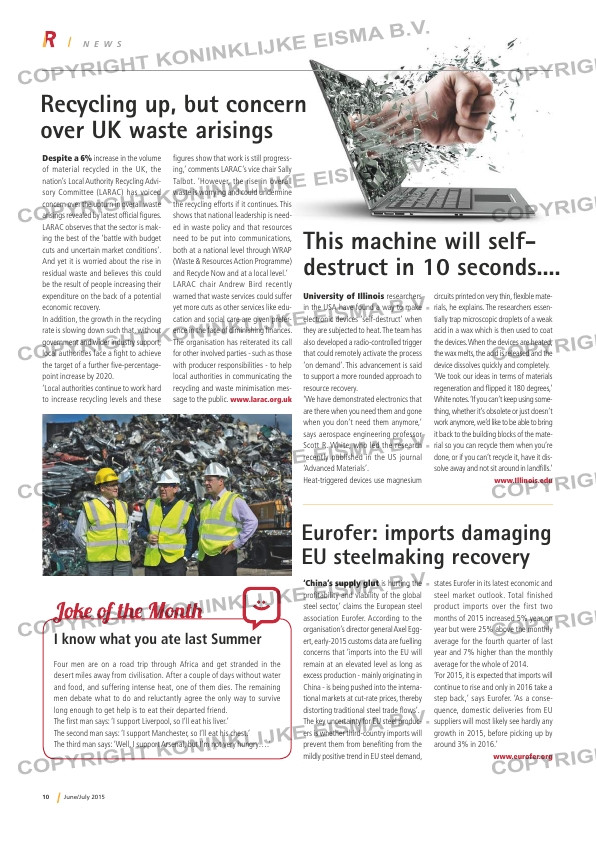Page 10 from: June / July 2015

10 June/July 2015
N E W S
I know what you ate last Summer
Four men are on a road trip through Africa and get stranded in the
desert miles away from civilisation. After a couple of days without water
and food, and suffering intense heat, one of them dies. The remaining
men debate what to do and reluctantly agree the only way to survive
long enough to get help is to eat their departed friend.
The first man says: ‘I support Liverpool, so I’ll eat his liver.’
The second man says: ‘I support Manchester, so I’ll eat his chest.’
The third man says: ‘Well, I support Arsenal, but I’m not very hungry….’
Despite a 6% increase in the volume
of material recycled in the UK, the
nation’s Local Authority Recycling Advi-
sory Committee (LARAC) has voiced
concern over the upturn in overall waste
arisings revealed by latest official figures.
LARAC observes that the sector is mak-
ing the best of the ‘battle with budget
cuts and uncertain market conditions’.
And yet it is worried about the rise in
residual waste and believes this could
be the result of people increasing their
expenditure on the back of a potential
economic recovery.
In addition, the growth in the recycling
rate is slowing down such that, without
government and wider industry support,
local authorities face a fight to achieve
the target of a further five-percentage-
point increase by 2020.
‘Local authorities continue to work hard
to increase recycling levels and these
figures show that work is still progress-
ing,’ comments LARAC’s vice chair Sally
Talbot. ‘However, the rise in overall
waste is worrying and could undermine
the recycling efforts if it continues. This
shows that national leadership is need-
ed in waste policy and that resources
need to be put into communications,
both at a national level through WRAP
(Waste & Resources Action Programme)
and Recycle Now and at a local level.’
LARAC chair Andrew Bird recently
warned that waste services could suffer
yet more cuts as other services like edu-
cation and social care are given prefer-
ence in the face of diminishing finances.
The organisation has reiterated its call
for other involved parties – such as those
with producer responsibilities – to help
local authorities in communicating the
recycling and waste minimisation mes-
sage to the public. www.larac.org.uk
Recycling up, but concern
over UK waste arisings
‘China’s supply glut is hurting the
profitability and viability of the global
steel sector,’ claims the European steel
association Eurofer. According to the
organisation’s director general Axel Egg-
ert, early-2015 customs data are fuelling
concerns that ‘imports into the EU will
remain at an elevated level as long as
excess production – mainly originating in
China – is being pushed into the interna-
tional markets at cut-rate prices, thereby
distorting traditional steel trade flows’.
The key uncertainty for EU steel produc-
ers is whether third-country imports will
prevent them from benefiting from the
mildly positive trend in EU steel demand,
states Eurofer in its latest economic and
steel market outlook. Total finished
product imports over the first two
months of 2015 increased 5% year on
year but were 25% above the monthly
average for the fourth quarter of last
year and 7% higher than the monthly
average for the whole of 2014.
‘For 2015, it is expected that imports will
continue to rise and only in 2016 take a
step back,’ says Eurofer. ‘As a conse-
quence, domestic deliveries from EU
suppliers will most likely see hardly any
growth in 2015, before picking up by
around 3% in 2016.’
www.eurofer.org
Eurofer: imports damaging
EU steelmaking recovery
University of Illinois researchers
in the USA have found a way to make
electronic devices ‘self-destruct’ when
they are subjected to heat. The team has
also developed a radio-controlled trigger
that could remotely activate the process
‘on demand’. This advancement is said
to support a more rounded approach to
resource recovery.
‘We have demonstrated electronics that
are there when you need them and gone
when you don’t need them anymore,’
says aerospace engineering professor
Scott R. White, who led the research
recently published in the US journal
‘Advanced Materials’.
Heat-triggered devices use magnesium
circuits printed on very thin, flexible mate-
rials, he explains. The researchers essen-
tially trap microscopic droplets of a weak
acid in a wax which is then used to coat
the devices. When the devices are heated,
the wax melts, the acid is released and the
device dissolves quickly and completely.
‘We took our ideas in terms of materials
regeneration and flipped it 180 degrees,’
White notes. ‘If you can’t keep using some-
thing, whether it’s obsolete or just doesn’t
work anymore, we’d like to be able to bring
it back to the building blocks of the mate-
rial so you can recycle them when you’re
done, or if you can’t recycle it, have it dis-
solve away and not sit around in landfills.’
www.Illinois.edu
This machine will self-
destruct in 10 seconds….
RI 5- NEWS.indd 10 15-06-15 11:57



